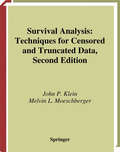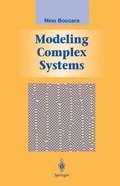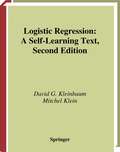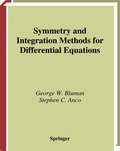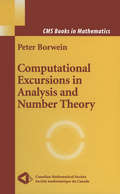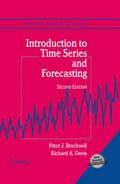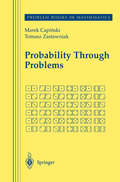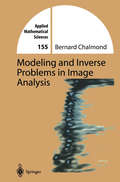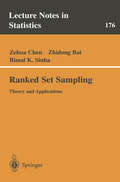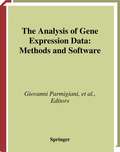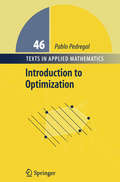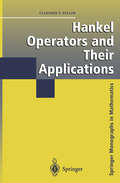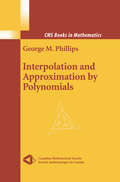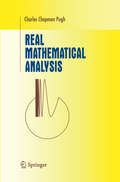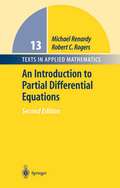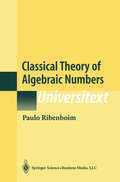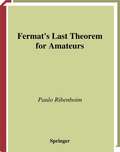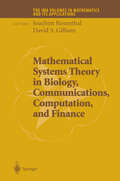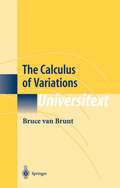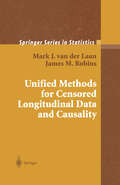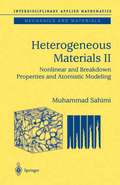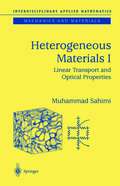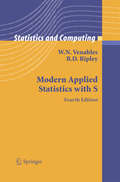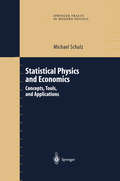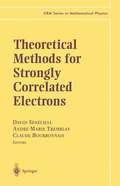- Table View
- List View
Survival Analysis: Techniques for Censored and Truncated Data (Statistics for Biology and Health)
by John P. Klein Melvin L. MoeschbergerApplied statisticians in many fields must frequently analyze time to event data. While the statistical tools presented in this book are applicable to data from medicine, biology, public health, epidemiology, engineering, economics, and demography, the focus here is on applications of the techniques to biology and medicine. The analysis of survival experiments is complicated by issues of censoring, where an individual's life length is known to occur only in a certain period of time, and by truncation, where individuals enter the study only if they survive a sufficient length of time or individuals are included in the study only if the event has occurred by a given date. The use of counting process methodology has allowed for substantial advances in the statistical theory to account for censoring and truncation in survival experiments. This book makes these complex methods more accessible to applied researchers without an advanced mathematical background. The authors present the essence of these techniques, as well as classical techniques not based on counting processes, and apply them to data. Practical suggestions for implementing the various methods are set off in a series of Practical Notes at the end of each section. Technical details of the derivation of the techniques are sketched in a series of Technical Notes. This book will be useful for investigators who need to analyze censored or truncated life time data, and as a textbook for a graduate course in survival analysis. The prerequisite is a standard course in statistical methodology.
Modeling Complex Systems (Graduate Texts in Contemporary Physics)
by Nino BoccaraThis book explores the process of modeling complex systems in the widest sense of that term, drawing on examples from such diverse fields as ecology, epidemiology, sociology, seismology, as well as economics. It also provides the mathematical tools for studying the dynamics of these systems. Boccara takes a carefully inductive approach in defining what it means for a system to be "complex" (and at the same time addresses the equally elusive concept of emergent properties). This is the first text on the subject to draw comprehensive conclusions from such a wide range of analogous phenomena.
Logistic Regression: A Self-Learning Text (Statistics for Biology and Health)
by David G. Kleinbaum Mitchel KleinThis is the second edition of this text on logistic regression methods, ori- nally published in 1994. As in the first edition, each chapter contains a presentation of its topic in “lecture-book” format together with objectives, an outline, key formulae, practice exercises, and a test. The “lecture-book” has a sequence of illust- tions and formulae in the left column of each page and a script (i.e., text) in the right column. This format allows you to read the script in conjunction with the illustrations and formulae that highlight the main points, formulae, or examples being presented. This second edition has expanded the first edition by adding five new ch- ters and a new appendix. The five new chapters are Chapter 9. Polytomous Logistic Regression Chapter 10. Ordinal Logistic Regression Chapter 11. Logistic Regression for Correlated Data: GEE Chapter 12. GEE Examples Chapter 13. Other Approaches for Analysis of Correlated Data Chapters 9 and 10 extend logistic regression to response variables that have more than two categories. Chapters 11–13 extend logistic regression to gen- alized estimating equations (GEE) and other methods for analyzing cor- lated response data. The appendix is titled “Computer Programs for Logistic Regression” and p- vides descriptions and examples of computer programs for carrying out the variety of logistic regression procedures described in the main text. The so- ware packages considered are SAS Version 8.0, SPSS Version 10.0, and STATA Version 7.0.
Symmetry and Integration Methods for Differential Equations (Applied Mathematical Sciences #154)
by George Bluman Stephen AncoThis text discusses Lie groups of transformations and basic symmetry methods for solving ordinary and partial differential equations. It places emphasis on explicit computational algorithms to discover symmetries admitted by differential equations and to construct solutions resulting from symmetries. This new edition covers contact transformations, Lie-B cklund transformations, and adjoints and integrating factors for ODEs of arbitrary order.
Computational Excursions in Analysis and Number Theory (CMS Books in Mathematics)
by Peter BorweinThis introduction to computational number theory is centered on a number of problems that live at the interface of analytic, computational and Diophantine number theory, and provides a diverse collection of techniques for solving number- theoretic problems. There are many exercises and open research problems included.
Introduction to Time Series and Forecasting (Springer Texts in Statistics)
by Peter J. Brockwell Richard A. DavisThis is an introduction to time series that emphasizes methods and analysis of data sets. The logic and tools of model-building for stationary and non-stationary time series are developed and numerous exercises, many of which make use of the included computer package, provide the reader with ample opportunity to develop skills. Statisticians and students will learn the latest methods in time series and forecasting, along with modern computational models and algorithms.
Probability Through Problems (Problem Books in Mathematics)
by Marek Capinski Tomasz Jerzy ZastawniakThis book of problems is designed to challenge students learning probability. Each chapter is divided into three parts: Problems, Hints, and Solutions. All Problems sections include expository material, making the book self-contained. Definitions and statements of important results are interlaced with relevant problems. The only prerequisite is basic algebra and calculus.
Modeling and Inverse Problems in Imaging Analysis (Applied Mathematical Sciences #155)
by Bernard ChalmondMore mathematicians have been taking part in the development of digital image processing as a science and the contributions are reflected in the increasingly important role modeling has played solving complex problems. This book is mostly concerned with energy-based models. Most of these models come from industrial projects in which the author was involved in robot vision and radiography: tracking 3D lines, radiographic image processing, 3D reconstruction and tomography, matching, deformation learning. Numerous graphical illustrations accompany the text.
Ranked Set Sampling: Theory and Applications (Lecture Notes in Statistics #176)
by Zehua Chen Zhidong Bai Bimal SinhaThe first book on the concept and applications of ranked set sampling. It provides a comprehensive review of the literature, and it includes many new results and novel applications. The detailed description of various methods illustrated by real or simulated data makes it useful for scientists and practitioners in application areas such as agriculture, forestry, sociology, ecological and environmental science, and medical studies. It can serve as a reference book and as a textbook for a short course at the graduate level.
The Analysis of Gene Expression Data: Methods and Software (Statistics for Biology and Health)
by Giovanni Parmigiani Elizabeth S. Garett Rafael A. Irizarry Scott L. ZegerThis book presents practical approaches for the analysis of data from gene expression micro-arrays. It describes the conceptual and methodological underpinning for a statistical tool and its implementation in software. The book includes coverage of various packages that are part of the Bioconductor project and several related R tools. The materials presented cover a range of software tools designed for varied audiences.
Introduction to Optimization (Texts in Applied Mathematics #46)
by Pablo PedregalThis undergraduate textbook introduces students of science and engineering to the fascinating field of optimization. It is a unique book that brings together the subfields of mathematical programming, variational calculus, and optimal control, thus giving students an overall view of all aspects of optimization in a single reference. As a primer on optimization, its main goal is to provide a succinct and accessible introduction to linear programming, nonlinear programming, numerical optimization algorithms, variational problems, dynamic programming, and optimal control. Prerequisites have been kept to a minimum, although a basic knowledge of calculus, linear algebra, and differential equations is assumed.
Hankel Operators and Their Applications (Springer Monographs in Mathematics)
by Vladimir PellerThe purpose of this book is to describe the theory of Hankel operators, one of the most important classes of operators on spaces of analytic func tions. Hankel operators can be defined as operators having infinite Hankel matrices (i. e. , matrices with entries depending only on the sum of the co ordinates) with respect to some orthonormal basis. Finite matrices with this property were introduced by Hankel, who found interesting algebraic properties of their determinants. One of the first results on infinite Han kel matrices was obtained by Kronecker, who characterized Hankel matri ces of finite rank as those whose entries are Taylor coefficients of rational functions. Since then Hankel operators (or matrices) have found numerous applications in classical problems of analysis, such as moment problems, orthogonal polynomials, etc. Hankel operators admit various useful realizations, such as operators on spaces of analytic functions, integral operators on function spaces on (0,00), operators on sequence spaces. In 1957 Nehari described the bounded Hankel operators on the sequence space £2. This description turned out to be very important and started the contemporary period of the study of Hankel operators. We begin the book with introductory Chapter 1, which defines Hankel operators and presents their basic properties. We consider different realiza tions of Hankel operators and important connections of Hankel operators with the spaces BMa and V MO, Sz. -Nagy-Foais functional model, re producing kernels of the Hardy class H2, moment problems, and Carleson imbedding operators.
Interpolation and Approximation by Polynomials (CMS Books in Mathematics)
by George M. PhillipsIn addition to coverage of univariate interpolation and approximation, the text includes material on multivariate interpolation and multivariate numerical integration, a generalization of the Bernstein polynomials that has not previously appeared in book form, and a greater coverage of Peano kernel theory than is found in most textbooks. There are many worked examples and each section ends with a number of carefully selected problems that extend the student's understanding of the text. The author is well known for his clarity of writing and his many contributions as a researcher in approximation theory.
Real Mathematical Analysis (Undergraduate Texts in Mathematics)
by Charles Chapman PughWas plane geometry your favourite math course in high school? Did you like proving theorems? Are you sick of memorising integrals? If so, real analysis could be your cup of tea. In contrast to calculus and elementary algebra, it involves neither formula manipulation nor applications to other fields of science. None. It is Pure Mathematics, and it is sure to appeal to the budding pure mathematician. In this new introduction to undergraduate real analysis the author takes a different approach from past studies of the subject, by stressing the importance of pictures in mathematics and hard problems. The exposition is informal and relaxed, with many helpful asides, examples and occasional comments from mathematicians like Dieudonne, Littlewood and Osserman. The author has taught the subject many times over the last 35 years at Berkeley and this book is based on the honours version of this course. The book contains an excellent selection of more than 500 exercises.
An Introduction to Partial Differential Equations (Texts in Applied Mathematics #13)
by Michael Renardy Robert C. RogersPartial differential equations are fundamental to the modeling of natural phenomena. The desire to understand the solutions of these equations has always had a prominent place in the efforts of mathematicians and has inspired such diverse fields as complex function theory, functional analysis, and algebraic topology. This book, meant for a beginning graduate audience, provides a thorough introduction to partial differential equations.
Classical Theory of Algebraic Numbers (Universitext)
by Paulo RibenboimThe exposition of the classical theory of algebraic numbers is clear and thorough, and there is a large number of exercises as well as worked out numerical examples. A careful study of this book will provide a solid background to the learning of more recent topics.
Fermat’s Last Theorem for Amateurs
by Paulo RibenboimIn 1995, Andrew Wiles completed a proof of Fermat's Last Theorem. Although this was certainly a great mathematical feat, one shouldn't dismiss earlier attempts made by mathematicians and clever amateurs to solve the problem. In this book, aimed at amateurs curious about the history of the subject, the author restricts his attention exclusively to elementary methods that have produced rich results.
Mathematical Systems Theory in Biology, Communications, Computation and Finance (The IMA Volumes in Mathematics and its Applications #134)
by Joachim Rosenthal David S. GilliamThis volume contains survey and research articles by some of the leading researchers in mathematical systems theory - a vibrant research area in its own right. Many authors have taken special care that their articles are self-contained and accessible also to non-specialists.
The Calculus of Variations (Universitext)
by Bruce van BruntSuitable for advanced undergraduate and graduate students of mathematics, physics, or engineering, this introduction to the calculus of variations focuses on variational problems involving one independent variable. It also discusses more advanced topics such as the inverse problem, eigenvalue problems, and Noether’s theorem. The text includes numerous examples along with problems to help students consolidate the material.
Unified Methods for Censored Longitudinal Data and Causality (Springer Series in Statistics)
by Mark J. Laan James M RobinsA fundamental statistical framework for the analysis of complex longitudinal data is provided in this book. It provides the first comprehensive description of optimal estimation techniques based on time-dependent data structures. The techniques go beyond standard statistical approaches and can be used to teach masters and Ph.D. students. The text is ideally suitable for researchers in statistics with a strong interest in the analysis of complex longitudinal data.
Heterogeneous Materials: Nonlinear and Breakdown Properties and Atomistic Modeling (Interdisciplinary Applied Mathematics #23)
by Muhammad SahimiThis monograph describes and discusses the properties of heterogeneous materials, comparing two fundamental approaches to describing and predicting materials’ properties. This multidisciplinary book will appeal to applied physicists, materials scientists, chemical and mechanical engineers, chemists, and applied mathematicians.
Heterogeneous Materials I: Linear Transport and Optical Properties (Interdisciplinary Applied Mathematics #22)
by Muhammad SahimiThis monograph describes and discusses the properties of heterogeneous materials, including conductivity, elastic moduli, and dielectrical constant. The book outlines typical experimental methods, and compares the experimental data and the theoretical predictions. This multidisciplinary book will appeal to applied physicists, materials scientists, chemical and mechanical engineers, chemists, and applied mathematicians.
Modern Applied Statistics with S (Statistics and Computing)
by W.N. Venables B.D. RipleyA guide to using S environments to perform statistical analyses providing both an introduction to the use of S and a course in modern statistical methods. The emphasis is on presenting practical problems and full analyses of real data sets.
Statistical Physics and Economics: Concepts, Tools, and Applications (Springer Tracts in Modern Physics #184)
by Michael SchulzThis systematic book covers in simple language the physical foundations of evolution equations, stochastic processes and generalized Master equations applied on complex economic systems, helping to understand the large variability of financial markets, trading and communications networks.
Theoretical Methods for Strongly Correlated Electrons (CRM Series in Mathematical Physics)
by David Sénéchal Claude Bourbonnais Ándre-Marie TremblayFocusing on the purely theoretical aspects of strongly correlated electrons, this volume brings together a variety of approaches to models of the Hubbard type - i.e., problems where both localized and delocalized elements are present in low dimensions. The chapters are arranged in three parts. The first part deals with two of the most widely used numerical methods in strongly correlated electrons, the density matrix renormalization group and the quantum Monte Carlo method. The second part covers Lagrangian, Functional Integral, Renormalization Group, Conformal, and Bosonization methods that can be applied to one-dimensional or weakly coupled chains. The third part considers functional derivatives, mean-field, self-consistent methods, slave-bosons, and extensions.
